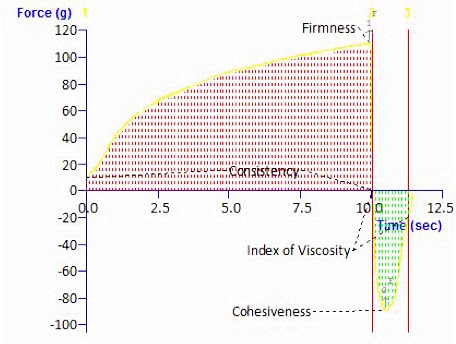 CRISPNESS/CRUNCHINESS/BRITTLENESS is a property manifested by a tendency when subjected to an applied force to yield suddenly with a characteristic sound.
CRISPNESS/CRUNCHINESS/BRITTLENESS is a property manifested by a tendency when subjected to an applied force to yield suddenly with a characteristic sound. It is commonly the textural property possessed by snacks (potato chips), breakfast cereals, fresh fruit and vegetables and some baked products (biscuits, crackers). These types of products are usually associated with sharp triangular curves displaying an obvious break point (when tested individually) or produce a 'jagged' multi-peak curve when tested 'in bulk'.
 The number of peaks produced are as a result of the fracture events that have occurred during the test. Counting the number of force peaks, the average dropoff and measuring linear distance are common calculations applied to such curves. Crispness is usually associated with many small fracture peaks. Whilst a crunchier product may possess the same number of curves, the drop from peak to trough will be significantly higher and the linear distance increased accordingly.
The number of peaks produced are as a result of the fracture events that have occurred during the test. Counting the number of force peaks, the average dropoff and measuring linear distance are common calculations applied to such curves. Crispness is usually associated with many small fracture peaks. Whilst a crunchier product may possess the same number of curves, the drop from peak to trough will be significantly higher and the linear distance increased accordingly.BRITTLENESS/FRACTURABILITY is the tendency of a material to fracture, crumble, crack, shatter or fail upon the application of a relatively small amount of force or impact. It is usually displayed by a product of high degree of hardness and low degree of cohesiveness and is commonly the textural property possessed by baked goods, snacks and generally 'dry' products.
Fracturability encompasses crumbliness, crispiness, crunchiness and brittleness. A material is brittle if it is liable to fracture when subjected to stress. That is, it has little tendency to deform (or strain) before fracture and usually makes a snapping sound.
 The Acoustic Envelope Detector can by employed for any material which produces an audible noise when tested as it captures another dimension (i.e. sound) during the test which can also be analysed and used as a measured product feature. This is usually applied to brittle materials and the acoustic signal is as a result of a crack, break, snap or failure of some type.
The Acoustic Envelope Detector can by employed for any material which produces an audible noise when tested as it captures another dimension (i.e. sound) during the test which can also be analysed and used as a measured product feature. This is usually applied to brittle materials and the acoustic signal is as a result of a crack, break, snap or failure of some type. Typical Methods & Fixtures for
Crispness/Brittleness/Fracturability Measurement
in action:
Typical physical properties that can be obtained from a texture analysis graph:
Rupture point, crispness, fracturability, crunchiness, brittleness, fracture strength, fracture distance, work of failure, breaking strength.
A wide range of attachments is available for measuring texture analysis properties.
 |
| Typical Texture Analyser graph with annotated properties |
We can of course design and manufacture probes or fixtures for the TA.XTplus texture analyser that are bespoke to your sample and its specific measurement.
Once your measurement is performed our expertise in its graphical interpretation is unparalleled – no-one understands texture analysis like we do. Not only can we develop the most suitable and accurate method for the testing of your sample but we can prepare analysis procedures that obtain the desired parameters from your curve and drop them into a spreadsheet or report designed around your requirements.
For more information on how to measure texture, please visit the Texture Analysis Properties section on our website.
To discuss your specific test requirements click here...
 |  |  |

No comments:
Post a Comment